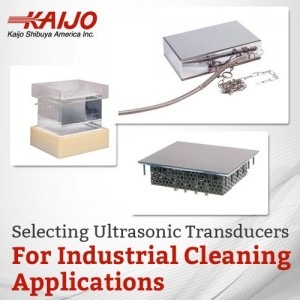Selecting Ultrasonic Transducers for Industrial Cleaning Applications
March 15, 2017
 Ultrasonic cleaning systems consist of an ultrasonic generator, a transducer and a cleaning tank. The generator produces the electric signal at the selected frequency while the ultrasonic cleaning transducer changes the signal into compression waves in the cleaning solution. The cavitation bubbles that are responsible for the cleaning action of the system appear in the troughs of these compression waves.
Ultrasonic cleaning systems consist of an ultrasonic generator, a transducer and a cleaning tank. The generator produces the electric signal at the selected frequency while the ultrasonic cleaning transducer changes the signal into compression waves in the cleaning solution. The cavitation bubbles that are responsible for the cleaning action of the system appear in the troughs of these compression waves.
The transducer produces compression waves through the action of piezoelectric material that expands and contracts when subjected to the electric signal. The transducer uses the electric signal from the ultrasonic generator to change the height of its piezoelectric material in tune with the signal. That way it can generate compression waves when its metal surface, tightly bonded to the piezoelectric material, vibrates at the selected frequency.
Ultrasonic cleaners can help improve productivity in industrial manufacturing plants that require cleaning of parts, components and tools. Mounting ultrasonic transducers on cleaning tanks can result in faster and more complete cleaning and a reduction in the use of harsh chemicals. Cleaning systems using these transducers can clean machined parts, tools, wires, lenses, glass and ceramics without damaging them and the systems can clean complex geometries, holes and crevices where traditional cleaning methods fail.
Physical Characteristics of Ultrasonic Cleaning Transducers
Ultrasonic transducers arrays must be able to withstand severe vibrations, immersion in cleaning solutions and high temperatures. Their construction must be heavy and rugged enough to be able to generate powerful compression waves and their surfaces must be designed to resist pitting due to the action of cavitation bubbles.
Kaijo transducer elements are hermetically sealed in a 316L polished stainless steel housing. They are designed to withstand immersion in cleaning solutions up to 100 degrees Centigrade and their piezoelectric characteristics will not degrade over time. The heavy duty enclosure and internal arrangement withstand the intense vibrations at high power and low ultrasonic frequencies and their surfaces can withstand cavitation.
Kaijo transducers are available in bolt-on, immersible or mounted versions. The immersible transducer is an independent unit connected to an ultrasonic generator via a cable. It can be placed in any tank and can be moved at any time. The immersible transducer is ideal for applications where there are a number of existing tanks and flexibility with different cleaning tasks is required.
Mounted transducers are integrated into tanks and are usually purchased with the tank for clearly defined cleaning applications. Bolt-on transducers are similar to mounted units but can be bolted onto the bottom or sides of tanks in single or multiple-unit configurations.
Electrical Characteristics
Key process parameters for ultrasonic cleaning systems are frequency, power and transducer characteristics. The ultrasonic frequency determines the size of the cavitation bubbles and the intensity of the cleaning action. Low frequencies generate comparatively large bubbles for robust cleaning while high frequencies produce smaller bubbles with a gentle cleaning action. The transducers have to be able to operate at the frequency selected for the system.
The system power, in watts, determines total cleaning power. Large tanks need more power and may require several transducers for optimum cleaning. Kaijo can help customers determine which frequencies are appropriate for their cleaning application and how much power they will need.
Kaijo ultrasonic sets are available for a complete range of frequencies from 26 kHz to 2MHz and with variable power output maximums of 600W or 1200W. In addition to offering ultrasonic systems and ultrasonic cleaning transducers as standard products, Kaijo has the experience and in house expertise to evaluate customer needs and propose custom solutions.





